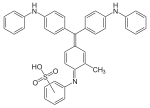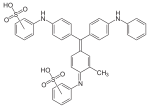Aniline blue
| Structural formula | |||||||||||||
|---|---|---|---|---|---|---|---|---|---|---|---|---|---|

|
|||||||||||||
| General | |||||||||||||
| Surname | Aniline blue | ||||||||||||
| other names |
|
||||||||||||
| Molecular formula | C 38 H 31 N 3 | ||||||||||||
| External identifiers / databases | |||||||||||||
|
|||||||||||||
| properties | |||||||||||||
| Molar mass | 529.68 g · mol -1 | ||||||||||||
| Physical state |
firmly |
||||||||||||
| Melting point |
222 ° C |
||||||||||||
| solubility |
almost insoluble in water, soluble in alcohol |
||||||||||||
| safety instructions | |||||||||||||
|
|||||||||||||
| As far as possible and customary, SI units are used. Unless otherwise noted, the data given apply to standard conditions . | |||||||||||||
Aniline blue is a solvent dye from the group of triphenylmethane dyes .
Although there are various blue dyes that can be produced from aniline, this name only refers to a certain color, which is known as ordinary aniline blue or fuchsine blue (Bleu de Lyon, Bleu de Paris) and consists of the hydrogen chloride compound of triphenylrosaniline (triphenylrosaniline chlorohydrate). It is a dark red-brown powder that is insoluble in water, but it dissolves in alcohol with a gorgeous blue color ( alcohol- soluble aniline blue). Three different types of aniline blue that are soluble in water can be produced from this (water-soluble aniline blue, see below). These are the sodium salts of paired sulfonic acids of triphenylrosaniline. They are obtained by the action of concentrated sulfuric acid on the aniline blue and, depending on the duration of the action and the level of the temperature, either 1, 2 or 3 molecules of sulfuric acid can be bound. When diluted with water, these dyes are separated out and can then be dissolved using sodium hydroxide solution . The water-soluble aniline blue, which was previously used alone, contains 3 molecules of sulfuric acid and is therefore triphenylrosaniline trisulfonic acid sodium. A., which contains 2 molecules of sulfuric acid, triphenylrosaniline disulphous acid soda, is called water blue (bleusoluble). The same dye, however, prepared in a different way, namely from diphenylamine , is called Bavarian blue. It is a dark blue powder, while the water blue shows a copper-red metallic sheen. With 1 molecule of sulfuric acid, the triphenylrosaniline monosulfonic acid soda is produced, which is also available in two types, namely from rosaniline prepared as Nicholsons blue or alkali blue, and from diphenylamine prepared as alkali blue D. Both are dark blue powders, soluble in water with a wonderful blue color.
Aniline blue is formed when rosaniline C 20 H 21 N 3 O is heated with excess aniline and a little benzoic acid to 180 ° C, whereby the benzoic acid remains unchanged ( monophenylrosaniline is red-violet, diphenylrosaniline blue-violet, triphenylrosaniline is pure blue). The aniline blue deposited with hydrochloric acid is the hydrochloric acid salt of the base . It forms green iridescent needles, is sparingly soluble in hot alcohol and not soluble in water. It comes on the market as gentiana blue, light blue, fuel blue, opal blue, fine blue. It dyes wool greenish blue . It forms sulfonic acids with concentrated sulfuric acid . The monosulfonic acid C 38 H 30 N 3 (HSO 3 ) is amorphous , blue, insoluble in water and forms colorless, non-crystallizable, easily soluble salts, of which the sodium salt is used as alkali blue (Nicholson's blue, soluble A.). It fixes itself from a weakly alkaline solution on wool and silk , but has to be treated with diluted acid. Salts of di-, tri- and tetrasulfonic acids, which are soluble in water, form water blue (opal blue, china blue , cotton blue, Bavarian blue); they are blue, only slightly soluble in water and alcohol and are used in particular for dyeing wool and silk and cotton is stained with alum and soap or with tannin and tartrate.
Aniline blue soluble in water
Aniline blue soluble in water (CAS No. 8004-91-9) is a mixed dye made from the two triphenylmethane dyes Acid Blue 22 ( water blue , CAS No. 28631-66-5) and Acid Blue 93 ( methyl blue , CAS No. 28983-56 -4). The chemical composition of this dye varies considerably from one supplier to another. The two individual components are often also listed under this name, but all three dyes can be distinguished by their CAS number.
Individual evidence
- ↑ a b Data sheet Solvent Blue 43 from Sigma-Aldrich , accessed on June 16, 2011 ( PDF ).
- ↑ This substance has either not yet been classified with regard to its hazardousness or a reliable and citable source has not yet been found.
- ↑ Entry on aniline blue white. In: Römpp Online . Georg Thieme Verlag, accessed on November 10, 2014.
- ↑ Aniline blue dyes
Web links
- Aniline blue , in the public domain Meyers 1905
- Aniline blue . In: Merck's Warenlexikon . 3rd ed. 1884 ff., P. 19 f.



